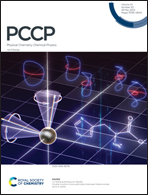Free carrier-mediated ferromagnetism in nonmagnetic ion (Bi–Li) codoped ZnO nanowires
Abstract
Non-magnetic dopants and p-type materials are attractive choices to explore the mechanism and origin of room-temperature defect-based ferromagnetism in metal oxide-based DMSs. In this study, we performed comprehensive transport, magnetic, structural, optical, and compositional as well as DFT studies of pristine, Li-doped, and Bi–Li codoped vertically aligned ZnO NW films to explore the mechanism and origin of ferromagnetism. We used a simple solution process to synthesize a wurtzite structure and vertically aligned ZnO NWs on a Si substrate. The doping, high crystallinity, and vertical alignment along the 002 planes were evidenced through HRTEM, FESEM, and XRD measurements. The XPS analysis confirmed the +1 and +3 states of Li and Bi, respectively. Moreover, Raman analysis also depicted the characteristic peaks of ZnO NWs at 98.31 cm−1 and 437.71 cm−1. The PL studies of doped NWs showed a typical NBE peak of ZnO at ∼395 nm along with a sub-gap defect-related broad peak at ∼504 nm indicating the presence of defects due to doping. The pure ZnO NW samples showed negligible saturation magnetization (Ms) at room temperature while the saturation magnetization was observed to increase with Li-doping and reduced with Bi–Li codoping. According to the Hall studies the pure ZnO NW film showed n-type conductivity, while all doped and codoped samples showed p-type conductivity. The hole concentration was observed to increase with Li-doping and decrease with Bi–Li codoping showing similar behavior to that of the Ms value, thereby suggesting a direct correlation between Ms and carrier concentration. The I–V properties showed a similar trend to that of carrier concentration and Ms. Our DFT studies showed that magnetization increased by Li doping and reduced by Li–Bi codoping in defective ZnO crystals by replacing Zn with Li and Bi atoms at the Zn site. Overall, our studies highlight the immense potential of hole-mediated Bi–Li codoped ZnO NW devices which are expected to play a pivotal role in developing spintronic devices.



 Please wait while we load your content...
Please wait while we load your content...